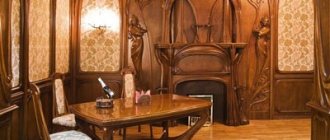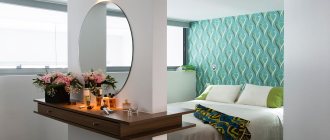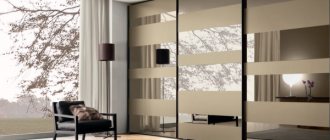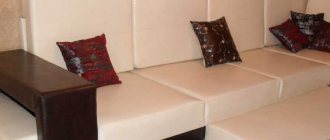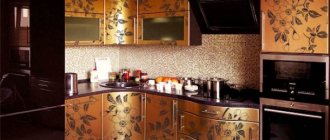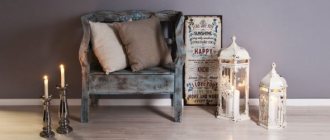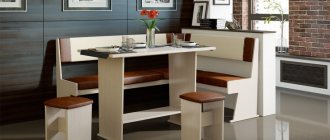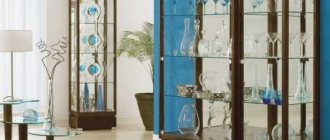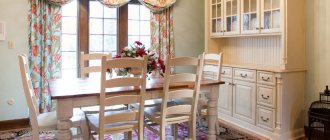36464
Suitable material for furniture is selected based on its functionality and the conditions in which it is used. Despite the conservatism of this market segment, more modern and practical types appear every year. Therefore, craftsmen who make furniture themselves must constantly monitor new trends and the emergence of wear-resistant materials.
Accessories
Furniture fittings are divided into internal and external. Internal fittings include hinges, door stops, stops, brackets, fastening strips, and external fittings include handles, supports, plugs and legs. External elements are made from materials with high decorative properties, and for internal fittings reliability is more important.
The production of any furniture product is not complete without the use of auxiliary accessories.
Experts divide fittings depending on technical functions:
- To connect parts to each other: all kinds of guides, handles, legs and fasteners;
- Rotating mechanisms: hinges, bearings, so-called swing devices;
- Transformation mechanisms: roll-out devices, lifts for tabletops and seats, recliners.
It is worth noting that high-quality fittings are a serious investment. According to experts, its price can reach up to 15% of the cost of a furniture set. But such expenses are completely justified, since it is low-quality fittings that begin to fail first, and not wood, metal or chipboard. And if a fastener breaks or falls out, it is not always possible to repair it.
Furniture fittings are all kinds of fasteners, handles, curtains, supports and decorative elements.
Popular materials
The main material for the manufacture of cabinet furniture is wood. It can be natural or in the form of pressed wood slabs. Solid wood costs a lot, so most furniture sets are made from all sorts of analogues.
Chipboard
A very popular material due to its low cost, suitable for the manufacture of cabinet and upholstered furniture for offices and apartments. Chipboard is made from waste from the woodworking industry, fixing sawdust with glue and hot pressing. The top of the slabs is painted with enamel and covered with laminated film.
Advantages of particle board panels:
- a wide range of;
- affordable price.
Minuses:
- crumble in damp areas;
- they do not always look respectable;
- Self-tapping screws, screws and other fasteners do not hold tightly enough.
In addition, it is important to remember that low-quality chipboards can emit harmful substances due to the possible presence of formaldehyde resins in the adhesive composition.
It is important to pay attention to the class of raw materials and ask sellers for certificates of quality and compliance.
laminated chipboard
The material is particle boards covered with a special laminated film. It tolerates moisture better than chipboard and has an attractive appearance. The boards are made from wood fibers bonded with artificial resins.
The mass is pressed, then polished and at the final stage covered with a special polymer film made of paper with the addition of melamine resin. The most expensive LSDPs are coated with a special varnish that protects them from dampness and scratches. The material is used for the manufacture of any furniture in the budget price segment, including kitchen sets.
Advantages of laminated chipboard:
- resistance to moisture, high temperatures;
- low cost;
- ease of processing.
Raw materials also have disadvantages. First of all, this is fragility - such furniture lasts no more than 10 years. In addition, since we are talking about a type of chipboard, the sawdust-binding resins may contain the same formaldehyde, which is poisonous to humans.
The nuances of assembling cabinet furniture, useful tips for beginners
MDF
This is another type of artificial slab. In the process of their production, wood dust and only natural binders are used: paraffin and lignin. Modern MDF does not contain formaldehyde, so it can be used to make any furniture, including children's furniture.
Advantages of the material:
- not afraid of moisture, steam;
- high plasticity, thanks to which the plates can be used for the manufacture of convex and concave parts;
- excellent decorative effect;
- wide color palette;
- high density - the surface holds fasteners well.
MDF has only one drawback - its higher cost than other particle boards.
Solid wood
The most environmentally friendly material, made from solid blocks of wood. There is glued solid wood. It is made from layers of natural wood, gluing them into one, almost monolithic piece.
Glued solid wood is somewhat cheaper, but is in no way inferior in aesthetic and performance properties to natural wood. Furniture can be made from coniferous wood, oak, cherry, and ash. This is a material for elite class interiors.
Advantages of the array:
- impeccable appearance;
- normalizes the microclimate, absorbing and releasing moisture depending on the water content in the air;
- strong and durable;
- easy to process;
- restoration is possible.
Flaws:
- heavy weight, which is especially felt during transportation or rearrangement of furniture products;
- dries out at high temperatures;
- afraid of mechanical influences.
Furniture made from natural wood is placed in living rooms, executive offices and other rooms where the furnishings are subject to increased requirements in terms of respectability and beauty.
Metal
This material is used for the manufacture of high-tech furniture, garden and outdoor furniture. Metal allows manufacturers to expand the range of furniture products and support modern style trends. It is often combined with glass, which creates the impression of lightness, freedom, and light.
Advantages of the material:
- long service life;
- high strength;
- reliability;
- affordable price.
At the same time, metal is not suitable for making all interior items; for example, a metal cabinet looks out of place in a living room. In addition, according to most users, furniture made from this material does not create proper comfort.
Advantages of individual furniture design, stages of work
Plastic
The material occupies a solid niche in the manufacture of furniture for the street, offices, and catering. Plastic is suitable for products intended for open air. Almost any furniture is made from it:
- tables;
- chairs;
- armchairs;
- lockers;
- shelves;
- benches;
- sun loungers.
Advantages of the material:
- bright colors;
- variety of designs;
- easy transportation;
- practicality;
- easy care.
Plastic also has disadvantages. Such furniture does not fit into all interior styles. In addition, it deteriorates from high and low temperatures and can release toxic substances.
Glass
This raw material has long been used as a furniture material, because with its help many interior tasks are solved. Glass countertops, cabinet doors, shelves, bar counters are indispensable in modern interiors.
Advantages of the material:
- gives the space lightness;
- suitable for small spaces;
- a wide variety of finishes - spraying, matte, combination with stones, rhinestones, sandblasting patterns, broken glass effect;
- strength - for example, a coffee table made of modern glass can withstand more than a hundred kilograms of load.
It is worth remembering that glass requires careful care; this becomes a disadvantage for many users. In addition, the material is fragile and traumatic, so it is not suitable for all interior areas.
Glass furniture is not used to furnish children's rooms.
Fiberboard and veneer
Fiberboards are used in furniture production to a very limited extent. They are used to make the backs of cabinets and the bottoms of drawers. The material is obtained by pressing wood fibers. As a result, thin slabs are created that are unable to withstand even moderate pressure.
Veneer is obtained when the top layer of wood no more than 1 mm thick is removed. The material is used for decorative finishing of particle boards. It gives artificial wood analogues a natural look.
Advantages:
- environmental friendliness;
- affordable price;
- a light weight.
The disadvantages lie in the fragility and extremely low moisture resistance of the materials.
Fiberboard
Veneer
PVC and laminate
These materials are classified as coatings. Laminated or PVC films give wood panels a beautiful appearance. They are used to make edging for the ends and the actual rolls for gluing the slabs. The advantages of coatings are affordability and variety of shades. Significant disadvantages lie in the short service life and the impossibility of restoration.
PVC film
Laminate
Original ideas
Today, furniture is made not only from the materials listed above. Craftsmen are capable of literally turning anything they have at hand into a work of interior art. Warehouse pallets, tires, old metal barrels, and used household appliances are actively used.
It is generally impossible to imagine such stylistic trends as country, loft or Provence without a variety of hand made interior items, including furniture.
Finally, an original idea is always exclusive, and it doesn’t matter what kind of room you create interior items for - an office, a restaurant or your own bedroom - rest assured that this design solution will be unique, one of a kind.
Original designer furniture is produced in a single copy.
Still, ultimately, it's up to you to decide. What do you prefer: aesthetics and respectability, or accessibility and the ability to soon change the furniture to new and more modern ones. Are you ready to incur serious financial costs and purchase interior items made of natural wood, or do you prefer modern design solutions? The main thing is that you like the furniture.

